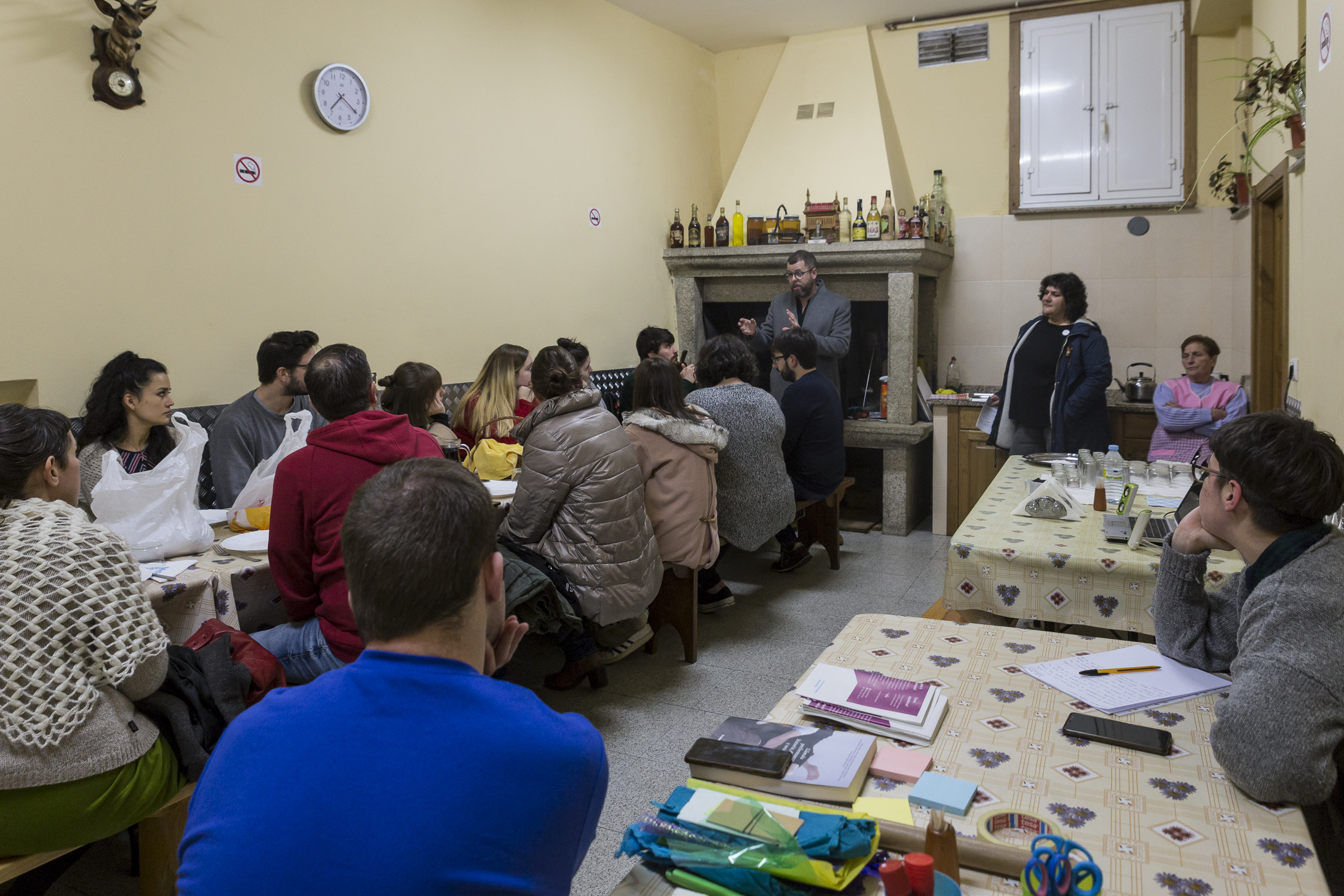Introduction Mutations in public space

Text by Sören Meschede and Fran Quiroga.
“A transformation of society implies the collective ownership and management of space through a constant intervention of the ‘stakeholders’ with their multiple, diverse and contradictory interests. Thus, through confrontation”.”
This publication, launched by Concomitentes in collaboration with Bartlebooth publishers, is the first in a series of books that seeks to delve into an idea of public space in its broadest sense, especially in the interstices between contemporary art and citizenship. With this collection we want to reinforce and accompany the projects we carry out in collaboration with civil society and on the territory, in order to emphasise the capacity of art to try out new ways of extending democracy.
Mutations in public space has as its starting point two interrelated phenomena that have accelerated in the pandemic: an increasingly regulated and controlled public space and lives increasingly centred on productivity, work and consumption. It would seem that during this pandemic time nothing else was happening, but on the contrary, in the public sphere inequalities were intensifying, controlling times, distancing communities, or sapping the power of the political imagination. With this book we want to begin to contribute, from the perspective of contemporary arts and culture, to the debate on what we have learned from this pandemic, both to think about the future of the public sphere and public space, and to investigate how we can reformulate, in social, material, subjective and symbiotic terms, our relationship with the planet and thus respond to the ecological crisis in which we have already submerged ourselves.
History has shown us that diseases and epidemics are more than mere episodes that barely interrupt the course of history. Indeed, it could be said that humanity is the evolution of an intimate symbiosis with microscopic pathogens that has been conditioning our relationship with each other and our surroundings, mutating the politics and institutions of societies around the world.
«Covid has also proved to be a plague with some transformative potential. Not only has it shown that it is capable of paralysing the economy and the daily life of citizens for a prolonged period of time».»
The proximity of death has made us more vulnerable, the fear of contagion has gone hand in hand with distrust of the other, sociability - understood as that web of mutual care and co-responsibility - has broken down and public space has shrunk.
It will probably not be possible, nor desirable, to pursue the desire to return to a “normal” state. Seen in this light, it is legitimate to ask whether it would not be better to consciously abandon our present way of life and use the pandemic as a catalyst, which offers the possibility of overcoming the status quo to now set the course for the future. another normality. The philosopher Naomi Klein calls this idea the doctrine of the shock and borrows from the writings of neoliberal economist Milton Friedman, who argues that every crisis can be seen as the ideal moment to promote a paradigm shift. Where Friedman saw an opportunity for the implementation of neoliberal policies, Klein interprets this moment as the right time for collective and social reflection and concludes: “We are at this moment where there are no non-radical options left (...) And what we mean by that is that climate change, if we don't change course, if we don't change our political and economic system, is going to change everything about our physical world”[1].
The pandemic will undoubtedly change our ways of doing society, the question is which path we will take: will these moments of uncertainty and social anxiety that we have experienced in 2020 become entrenched, diminishing personal affects, the construction of subjectivities or social interactions themselves? Or will we be able to learn from the observation of our shortcomings to dare to give way to a greater reflection on what defines us as a society and how we want to live in the future?
[1] Naomi Klein, «There are no non-radical options left before us», Salon, 04/02/2016, 'www.salon.com'.
Milton Friedman, Capitalism and Freedom, Chicago, Chicago, Chicago University Press, 1982, p. 8.
«Culture should not be left out of the responses to these processes, especially if it is conceived as a relevant social actor».»
At Concomitentes, this issue is particularly close to our hearts, because we are committed to the French project New Commanders, which has among its slogans “Faire art comme on fait societé”[Making art, as society is made]. When we founded our association in Spain in 2018, we adapted this insignia to indicate that Concomitentes is a project born from art, but also with a clear social impact. This double objective accompanies us constantly. On the one hand, we work so that contemporary art becomes an essential part of everyday life, but, on the other, that the projects affect, that they weave community from the awareness that public and social space is a place in permanent dispute.
In response to a shared desire and yearning to find out what 2020 and 2021 might mean for our common future, a research project was launched, which did not stop at an analysis of the here and now, but dared to look into the future. In April 2020, we launched a public survey under the title A questionnaire for the future, The questionnaire was conceived as a reflective exercise on two fundamental questions: the personal perception of an exceptional time and the desire to know what kind of society we want to live in. We took advantage of the conclusions provided by the responses of the 498 people who took part in this questionnaire to engage in a conversation with a heterogeneous group of social and cultural agents, with a clear invitation: to elucidate together on these mutations that are emerging in the public space. In parallel, we sought other voices and other points of view to dialogue and extend a conversation, more necessary than ever, on the need to reconfigure our relationships: among ourselves, with the planet, with power, with the norm, with the art-object or with the space-time relationship itself.

To facilitate the reading of Mutations in public space, We have grouped the material that emerged from this research into four blocks. The first of these, Beyond the norm, opens with Lifeless efficiencies, in which Fran Quiroga observes that the dictates of efficiency - understood from a productivist perspective - have increasingly dominated our private and, by extension, public spheres. Through various examples, he illustrates that this efficiency is not only ineffective, but is even detrimental to social and environmental settings, and advocates paying more attention to the unexpected and the unforeseen as a way of being more compatible with life. Amador Fernández-Savater and Marcos García take this debate, which Fran Quiroga situates more in the sphere of social and environmental ecologies, to the cultural sphere. In their conversation, entitled Inhabiting conflict, They start from the analysis that there is a lack of images of change that are capable of encouraging an interest in the transformation of our society. They locate the practices that could provide us with this imagination in the social and cultural movements of recent decades. Savater and García have been able to interpret uncertainty and improvisation, not as a threat, but as a challenge from which to provoke social transformations. Britain's Lyndsey Stonebridge also insists in her short essay The World to Come: A New Politics of Hope on the importance of our ability to dream other realities. It reminds us The principle of hope, by the philosopher Ernst Bloch, to insist that projecting hopes for the future is not a banal pastime, but “the longing for another form of existence”.
The second block, entitled Ecologies of the everyday, The first part of the book is about the concept of public space. Pandemic reinforces mutual support, Mary Mattingly's account of how the pandemic has generated a vast network of support and a new civic consciousness in New York, which can be understood as an act of resistance to the dismantling of public services in American society. This idea is taken up by Communicating the city: from consumption to care, the text by Maria Shéhérazade Guidici. Starting with an analysis of a fresco by Ambrogio Lorenzetti, which represents two visions of the 13th century city of Siena, she tells how the plague epidemic of 1347 meant the end of Siena's communal experiment and asks: “Can the current pandemic encourage us to rethink cities as places of care?” Guidici criticises the Western concept of public space as it was conceived from the Renaissance to the present day, for denying direct participation to the citizenry and transferring all responsibility for care to the state. José María Torres Nadal links this idea with ecologies and social justice. In Life, public space, the pandemic and architectureture, it elevates the defining framework of public space to a holistic concept, to function as a “territory of life”, a “public-public-political-body-space” to be cared for and attended to from a perspective beyond the human.

The block Public time starts with Where are you?, a very personal text by Leticia Sabsay, in which she analyses how the politics of confinement has re-popularised concepts such as “family nucleus” or “home”. The need to belong to a certain place and the spatio-temporal relationship have always been there, but, in the unison of our Western lives, it has lost importance. For Sabsay, the pandemic highlights the multitude of factors (geographical, familial, political...) that condition the answer to the questions "where are you? and how are you?", and concludes that, with the false security suggested by belonging to a certain place and time, we run the risk of forgetting that time and space can be plural and heterogeneous. In his contribution What is the weather like?, Jara Rocha and Amparo Lasén explore how the public policies of quarantine and confinement have affected this temporary personal perception and the emotional climates that accompany it; at the same time, they analyse, taking up an idea already perceived in the first block: how the permanent state of exception had already been in place and was accentuated by the pandemic. Athena Athanasiou also insists on this theme. In her text, Over and over again, no more, not yet., In this book, he elaborates a scathing critique of current capitalism and then reflects on the phenomenon that, even in times of crisis, we are not able to let our imagination run wild and are only able to fantasise in a responsible and (self-)regulated way. His question “how can we reclaim the imagination of collective life outside the normalising capacity of a present that limits and unfairly distributes these possibilities?” resonates in several of the texts in this publication.
We close the book with Art as a meeting place, which addresses the apparent gap between the reality of cultural institutions and their vocation to be a relevant public and social actor. At A strong museum, a vulnerable museum, Haizea Barcenilla and Eneas Bernal start from the paradox that the norms of social behaviour that were applied during the pandemic have been applied for decades in museums and cultural centres. Through five examples, they show how cultural spaces can house life experiences and ask what kind of relations we want to see between objects, bodies and spaces. This text is in dialogue with A tank on a pedestal, an essay by Hito Steyerl, published in 2017, in which the German artist launches an ingenious challenge to cultural institutions to strengthen their connection with current social issues, instead of limiting their role to safeguarding the past. It is complemented by a conversation between Alexander Koch, Anastassia Makridou-Bretonneau and Sören Meschede on the potential of artistic practices that try out new relational modes, and especially those that broaden democracy and happiness by continuing to build together.
«We finalised Mutations in public space with an approximation of the results of the survey A questionnaire for the future, a reflection on the choral perception of a specific moment, whose value lies in being a snapshot of a collective feeling at the beginning of the pandemic, with all the doubts, anxieties, frustrations and future yearnings that it brought with it».»
The pandemic has forced its way into the public space and this onslaught has brought to light political processes that had already been foreshadowed in recent decades: the growing normativisation of space, social inequality, distrust of the other, the dismantling of public or community initiatives and the desire for immediacy have been revealed more starkly in recent years. Mutations in public space is a bid to reconfigure the material and sensitive relations of our present, but, above all, it is an invitation to recover the joy of continuing to build together.










 Concomitentes
Concomitentes